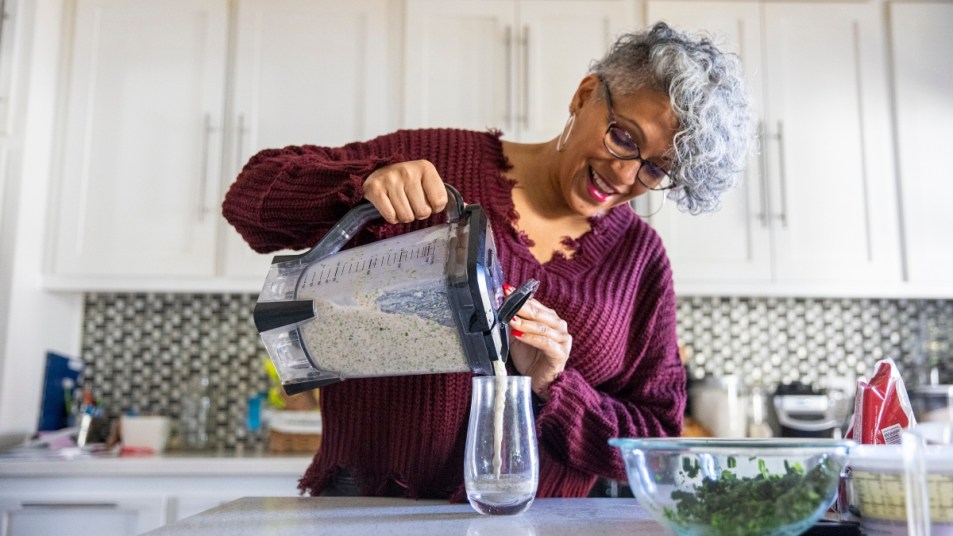Can’t Lose Weight? It Could Be What You’re Drinking

If you’re trying to cut calories and lose weight but the scale just isn’t budging, the problem may lie not with what you’re eating, but with what you’re drinking. Sugary beverages — including juice, milk, and alcohol — are a common source of excess calories, and indulging in them too often is enough to sabotage any healthy diet. And while drinking plenty of fluids is crucial for better health, some drinks might not be worth the extra carbs, sugar, and sodium. (The best drink? Plain water!)
But what should you do if you just can’t function without your morning glass of OJ? And do we really have to stick to drinking just water all the time? To better understand the issue, we reached out to Elaine Hinzey, RD, the educator and author behind wellness site What the Well. Hinzey believes there are easy steps you can take to improve your drinking habits, without having to go cold turkey on your favorite beverages. (Hint: It’s all about mindfulness!)
Here are nine ways to make sure your drinks aren’t sabotaging your diet:
Measure your fruit beverages.
Do you love drinking fruit juice in the morning? You don’t have to give it up completely, but you may want to slash your serving size in half.
“According to the American Heart Association, a serving of fruit juice is 1/4 cup, and a serving of vegetable juice is 1/2 cup,” says Hinzey. “Many people pour a 12-ounce glass of orange juice every morning without thinking twice about it. Also, be sure to choose 100 percent fruit juice. Some beverages, such as SunnyD, are as little as five percent fruit juice.”
Mix your fruit drinks with water or seltzer.
If you’re still craving a fruity beverage (or simply don’t like the taste of plain water), try adding one part water or seltzer to one part juice. “By mixing four ounces of orange juice or another fruit juice with four ounces of seltzer water, you will save 60 calories over drinking an eight-ounce serving of the juice alone,” Hinzey adds.
Make healthy food swaps for drinks.
Sometimes, we need a delicious pick-me-up in the form of a frappuccino or peppermint hot chocolate. When those drinks become a habit, however, they regularly add empty calories to our diet.
“Think about what you could eat for the same amount of calories,” says Hinzey. “For example, a Grande White Chocolate Mocha from Starbucks contains 430 calories. You could eat two small apples, a four-ounce chicken breast, a medium-sized baked sweet potato, and a cup of boiled broccoli for the same number of calories.”
Swap wine for wine spritzers.
Cutting out calories doesn’t mean you have to give up alcohol completely! It just means you may want to think about some simple swaps. “A six-ounce glass of wine contains roughly 150 calories,” Hinzey points out. “Instead, order a wine spritzer, which is wine mixed with club soda. This slashes the calories to a more manageable 70 calories per glass.”
Ditch the hard soda.
Speaking of alcohol, you may want to stay clear of mixed drinks that contain soda. “Hard sodas are not a better choice,” Hinzey says. “While a six-ounce glass of wine contains 150 calories and a 12-ounce bottle of Michelob Ultra Amber contains 90 calories, a bottle of Best Damn Root Beer adds 240 calories, and a bottle of Mike’s Hard Mango Punch is 230 calories.” In fact, sugary sodas are even linked to certain cancers.
Switch to a different milk.
Whether you use milk in your cereal and coffee (or like to drink a glass every now and then), you can cut calories by simply avoiding whole milk. “One cup of whole milk contains 146 calories, while a cup of skim milk only contains 80,” says Hinzey. Don’t like the flavor of skim? Try two percent, which is about 120 calories.
Measure your coffee additives.
We all love to doctor our coffee in different ways. But when it comes to creamers and sweeteners, measurements are key. “Keep in mind that most people use much more than a teaspoon of sugar or a tablespoon of creamer,” says Hinzey.
In addition, you might get more bang for your buck if you choose a creamer over a spoonful of sugar. “A measly teaspoon of sugar contains 16 calories, while a tablespoon of liquid coffee creamer will add at least 20 calories to your drink,” she adds.
Be cautious about smoothies.
“Think grabbing a smoothie while you’re running errands is a super-healthy way to get your fruits and vegetables in? Think again,” Hinzey says. “A 24-ounce smoothie can easily surpass 500 calories, nearly a third of the total calories that some women should ingest in an entire day.”
That doesn’t mean you have to give up smoothies, especially if they’re a highlight of your day. Instead, try making them at home. “If you make your smoothie at home, you can control what goes into it,” Hinzey points out. “Try adding more vegetables, using non-fat yogurt, and keeping an eye on how much fruit juice you’re adding to keep the number of calories manageable.”
Check the labels on your still and sparkling water.
Grabbing a flavored water off the shelf at your supermarket? Take a peek at the label first. “Not all water is calorie-free. You have to check every label,” Hinzey recommends. “For example, Vitaminwater often contains 100 calories per bottle, although the [company products] include sugar-free Vitaminwater zero-calorie beverages.”
At the end of the day, having a sugary drink every now and then isn’t detrimental to your health. But the calories can add up quickly! Being more mindful of what you consume is the key to changing your drinking habits — and could help you meet your weight loss goals.













